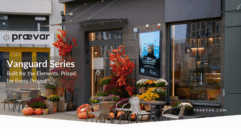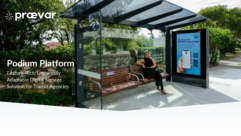

In Digital Signage Success Comes With Confusion
For the past five years, I’ve attended Digital Signage Expo (originally called the Digital Retailing Expo but rebranded to focus on what it’s really about). The first year, at Chicago’s Navy Pier, it was a small event.
For the past five years, I’ve attended Digital Signage Expo (originally called the Digital Retailing Expo but rebranded to focus on what it’s really about). The first year, at Chicago’s Navy Pier, it was a small event. All the significant players of the time were showing their wares, but it was still a fledgling event and you could see more signage at an InfoComm show. The next year it nearly doubled in size, both from a manufacturer and attendee standpoint. And quickly, in just a few years, it proved to be the premier event for those involved and interested in the art and science of all things digital signage.
Kris Vollrath, CTS
This year’s DSE was no exception. True, the economy affected attendance, but it didn’t keep all the major industry players from exhibiting. My company represents a good number of software platforms in the digital signage industry. And while it’s been said there are literally hundreds of solutions that fit the broadest definition of digital signage, there are only about 50 that an AV pro needs to follow. Many overlap or address specific market segments. But one thing’s for sure: This year’s DSE was the first where we saw differentiators fading away.
At the show, I took the opportunity to introduce a new digital signage salesperson to the industry. What we found is that it has become increasingly difficult to explain why our company offers one solution over another–or why yet another product even exists. That confusion fueled an issue that came up frequently during the show: With solutions growing more and more similar in terms of ability and methodology, what will this industry look like three, six, 12, or 18 months from now?
Even manufacturers and developers agree there will be a shakeout of companies in this, you’d have to say, still young industry. Which makes it that much harder to decide what products to carry and partnerships to forge. Who’s going to shake out? It’s important to do your homework.
Match Clients to Software
While there are many digital signage solutions out there, AV dealers should focus on a subset of them. If your core client base is anything like that of a traditional AV pro, then corporate, education, worship, and municipal organizations are your key verticals.
Knowing that is half the battle. You can now begin to look for partners who will provide solutions designed for your type of client. For example, solutions that are entirely advertising-driven, that rely heavily on a team of people managing the solution, are probably not for you. Such programs are not typically geared toward everyday people like school administrators or church volunteers. Although these solutions have their place in digital signage and are highly advanced, they don’t fit well into the digital messaging space where most pro AV dealers live.
That said, you write off these advanced solutions at your peril. Many ad-network-based solution providers are trying to make their software usable by a broader client base, which soon, if it hasn’t already, will make choosing a solution more difficult still.
So what are your choices? Let’s begin by defining some things. There are two main options when it comes to digital signage platforms. There’s the in-house solution and Software as a Service (SaaS).
In-house is a solution owned and managed by the client. SaaS is a pay-as-you-go model with the core infrastructure residing outside the client’s network and the player piece, which drives the displays located on the client’s premises, usually owned by the client. There also are some hybrids out there, such as a services model in which the client owns the system while the integrator manages it as an outsourced service.
A determining factor in a client’s decision to choose one platform over another is the way they plan to pay for the signage solution. SaaS requires a smaller capital outlay for players and displays, then the client uses operational funds to pay a monthly fee to the solution provider. Under the in-house model, the acquisition is often 100-percent capital expenditure. And we’ve all seen that more and more organizations have less and less capital expenditure at their disposal.
That’s why a lot of the big solution providers are either planning or have announced a SaaS variant of their software. If done well, that diversification–offering SaaS and client-hosted flavors–should buy those companies extra staying power in the industry and allow you to show clients you have the flexibility to build a system that addresses their situation.
Up to this point, we’ve had significant success selling solutions that the client owns, but we’ve seen little demand for the SaaS model. I expect that to change this year and beyond, so when looking for your partners, make sure you know a good a SaaS provider, too. They may be one and the same.
Fortunately, there’s still plenty of opportunity to grill digital signage companies about their products. Not only is InfoComm 09 in June, but Digital Signage Expo takes its show to the nation’s capital in September. But if you’re going to have success in finding a solution to offer, take the time to know your clients better. The key to succeeding in this space is understanding how your clients will use digital signage.
Corporate clients, for example, have to do far more with far fewer resources. Content owners will likely be content creators, too. And they may need more of your help as a services provider. Other client verticals have their own characteristics and needs.
Know your potential partners, too. Approach them based on your abilities and how their level of service fits in. Rule of thumb: What you can’t do yourself, a solution provider should do for you, whether its custom programming or technical support.
Become an expert in the solution(s) you represent. Don’t sell from a brochure; buy demo equipment, install the solution internally, use it in your lobby, and get people trained on implementation. Don’t go after the big projects right away–those will come in time. There are plenty of small and medium sized projects to hone your skills on in the meantime.
That’s no easy to-do list, considering the slew of options out there. But you can make it easier.
Kris Vollrath is vice president of Advanced AV in West Chester, Pa., an industry consultant, and frequent speaker on digital signage applications and technology.








